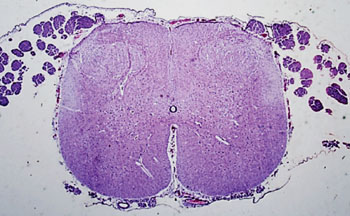Infant Stiff-Joint Syndromes Matched to Possible Genetic Origins
By LabMedica International staff writers
Posted on 26 May 2015
There are over 400 specific disorders that are, or can be, associated with multiple contractures in the newborn and a better understanding of disorders with contractures and their associated genetics is critical for accurate diagnosis and optimal treatment.Posted on 26 May 2015
Contractures are defined as joints that have reduced range of motion due to stiffening of normally flexible tissues and proper central and peripheral nervous system development and function are required for stimulation of muscle movement. Muscle tissue, ligaments, tendons, and skin require movement for normal development and function, without which, joints develop contractures.

Image: Histopathology of a spinal cord from an infant with multiple joint contractures present at birth (Photo courtesy of Dimitri P. Agamanolis, MD).
Scientists at the Translational Genomics Research Institute (Phoenix, AZ, USA) and their Canadian colleagues describe over 50 of the more than 400 rare, but specific, disorders associated with multiple muscle contractures and stiff joints among newborns. They affect arms, legs, torsos and other parts of the body, often in combinations. These more than 50 disorders are called "X-linked" syndromes, because the genes that cause them are on the X chromosome and unaffected mothers can pass them on to their children, most often to their sons.
The study, or compilation of studies, identified 20 different genes associated with three categories of these more than 50 syndromes. One category represented more than 20 syndromes in which the responsible X-linked genes have been identified. A second category represented seven distinct reports consistent with X-linkage and present with contractures. A third category represented an additional 20 syndromes with reported contractures that are suspected to be X-linked. The study's goal was to better enable physicians and geneticists to advance new treatments that might help these children.
Judith G. Hall, MD, emerita professor of medical genetics, University of British Columbia (Vancouver, BC, Canada) and a coauthor of the study said, “Clearly, there are many different causes of stiff joints in newborns. We wanted to bring together the clinical description of each of these syndromes, and match them to genes, the biochemistry of genes, and the cellular pathways, in order to identify potential therapies.” The study was published in the May 2015 issue of American Journal of Medical Genetics.
Related Links:
Translational Genomics Research Institute
University of British Columbia




 assay.jpg)









